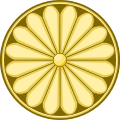State Emblem of India
The State Emblem of India is the national emblem of India. The emblem is taken from the Lion Capital of Ashoka, a statue from 250 BCE. The statue consists of four Asiatic lions back to back, with the two-dimensional emblem showing three lions.
| State Emblem of India | |
|---|---|
 | |
| Details | |
| Armiger | |
| Adopted | 26 January 1950 |
| Escutcheon | Lion Capital of Ashoka |
| Motto | Satyameva Jayate ("Truth Alone Triumphs") (from the "Mundaka Upanishad", a part of Hindu Vedas) |
An emblem based upon the Lion Capital of Ashoka was first adopted as the emblem of the Dominion of India in December 1947.[1] The current version of the emblem was officially adopted on 26 January 1950, the day India became a republic.[2]
State Emblem Of India Media
The original Lion Capital of Ashoka, 3rd century BCE, Sarnath Museum
Emblem of the Supreme Court of India
Emblem of the Central Bureau of Investigation
The State Emblem atop the dome of Vidhana Soudha, seat of the state legislature of Karnataka
Medieval royal insignia of the Pandya dynasty
Emblem of the Vijayanagara Empire
Insignia of the Ahom kingdom
Seal of the Mughal Empire
Seal of Shivajiraje Bhonsle I, 1st Chhatrapati of the Maratha Empire
Closing Seal of Shivajiraje Bhonsle I
References
- ↑ "Press Communique' - State Emblem" (PDF). Press Information Bureau of India - Archive. Archived (PDF) from the original on 8 August 2017.
- ↑ "State Emblem". Know India. Government of India. Archived from the original on 3 March 2016. Retrieved 1 May 2016.









